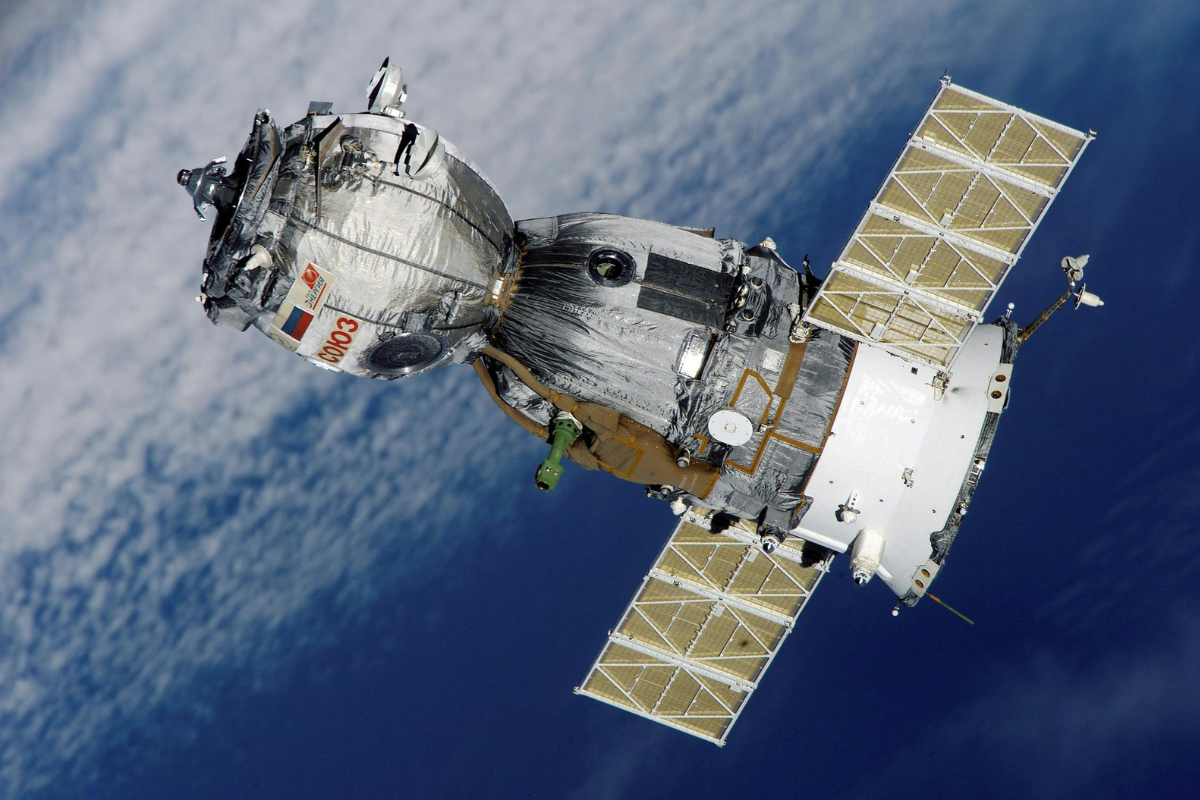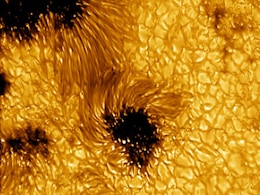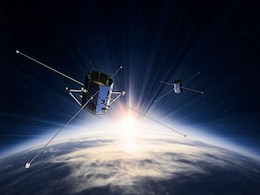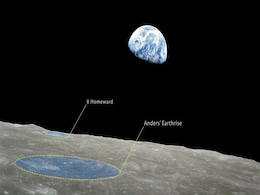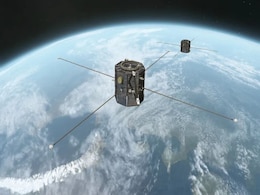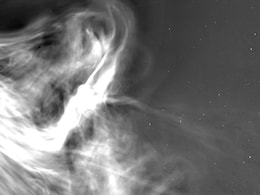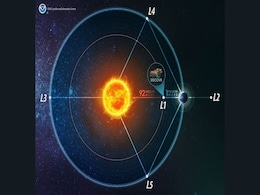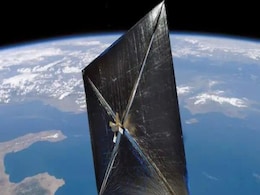Solar Power Satellites
- All
- News
-

NASA’s Parker Solar Probe Observes Solar Wind Making ‘U-Turn’, Shedding Light on Space Weather
- Wednesday December 17, 2025
- Written by Gadgets 360 Staff
NASA’s Parker Solar Probe captured solar wind reversing toward the sun, revealing how magnetic fields recycle coronal material. This process, seen during a close flyby, helps refine models of space weather and may allow scientists to better predict solar storms that can impact satellites, communications, and power systems across the solar system.
-
 www.gadgets360.com
www.gadgets360.com
-

Massive Sunspot Complex on the Sun Raises Risk of Strong Solar Storms
- Tuesday December 9, 2025
- Written by Gadgets 360 Staff
A massive sunspot complex has appeared on the Sun, covering an area comparable to the legendary Carrington Event region. Known as AR 4294-96, the active cluster features highly tangled magnetic fields that could unleash powerful solar flares and geomagnetic storms, potentially disrupting satellites, power grids, and global communications if Earth-d...
-
 www.gadgets360.com
www.gadgets360.com
-

With The Sun Nearing Its Peak, Aditya-L1 Prepares For Fierce Coronal Mass Ejections
- Monday December 1, 2025
- Science | Edited by Astitva Raj
Although CMEs do not directly harm humans, their impact on technological infrastructure can be severe.
-
 www.ndtv.com
www.ndtv.com
-

AI in Space: Why Elon Musk, Google, and Amazon Want to Make It the Next Frontier?
- Monday November 17, 2025
- Written by Akash Dutta, Edited by Rohan Pal
Major AI companies are exploring space-based data centres to cut energy and cooling costs. Google is researching solar-powered TPU satellites under Project Suncatcher, while Nvidia-backed Starcloud is preparing to launch an H100-equipped satellite powered entirely by solar energy. Leaders like Jeff Bezos and Elon Musk have also expressed interest, ...
-
 www.gadgets360.com
www.gadgets360.com
-

Skies Illuminate In Colours As Intense Solar Storm Brings Beautiful Auroras Worldwide: See Pics
- Thursday November 13, 2025
- Offbeat | Edited by Srishti Singh Sisodia
The recent solar storms are classified as G4 (severe) and G5 (extreme), causing widespread disruptions to satellite communications, GPS, and power grids.
-
 www.ndtv.com
www.ndtv.com
-

Solar Flare, Strongest Of 2025, Causes Widespread Radio Blackouts In Europe And Africa
- Wednesday November 12, 2025
- Science | Edited by Srishti Singh Sisodia
The X5.1-class flare has the potential to disrupt satellite communications, GPS and power grids.
-
 www.ndtv.com
www.ndtv.com
-

IMAP Space Weather Mission to Lift Off Soon, NASA Confirms Broadcast Plans
- Thursday September 18, 2025
- Written by Gadgets 360 Staff
NASA will stream the Sept. 23 launch of IMAP with two rideshare satellites from Kennedy Space Centre. IMAP will study the heliosphere, Carruthers will image Earth’s exosphere, and NOAA’s SWFO-L1 will provide early solar storm warnings. Together, the missions advance space weather science while protecting satellites, communications, and power sy...
-
 www.gadgets360.com
www.gadgets360.com
-

Astronomers Capture Sharpest-Ever Solar Flare Images with NSF’s DKIST Telescope
- Wednesday August 27, 2025
- Written by Gadgets 360 Staff
Astronomers have achieved a major breakthrough by capturing the sharpest images of a solar flare ever recorded, using the National Science Foundation’s Daniel K. Inouye Solar Telescope (DKIST). Observed at the hydrogen-alpha wavelength during the decay of an X1.3-class solar flare, the images unveiled hundreds of ultra-fine coronal loops averagin...
-
 www.gadgets360.com
www.gadgets360.com
-

NASA's TRACERS Satellites Begin Solar Wind Study Despite SV1 Glitch
- Wednesday August 6, 2025
- Written by Gadgets 360 Staff
NASA launched its twin TRACERS satellites on July 23, 2025, to study how solar wind causes magnetic reconnection in Earth's magnetosphere. However, a power issue on one spacecraft, SV1, has caused intermittent communication. Engineers believe the issue relates to sunlight availability on its solar panels and plan recovery efforts in August. Meanwhi...
-
 www.gadgets360.com
www.gadgets360.com
-

Solar Sail Spacecraft Could Boost Space Weather Warnings by Nearly 60 Minutes
- Monday August 4, 2025
- Written by Gadgets 360 Staff
A solar sail spacecraft could extend space weather warnings from 40 to 60 minutes, offering vital lead time before solar storms strike. Part of the SWIFT mission, this satellite will orbit farther than any current monitor, using sunlight for propulsion. The system aims to better protect satellites, astronauts, and power grids from geomagnetic disru...
-
 www.gadgets360.com
www.gadgets360.com
-

NASA’s Twin TRACERS Satellites Will Monitor Space Weather to Shield Earth from Solar Storms
- Monday July 21, 2025
- Written by Gadgets 360 Staff
NASA’s TRACERS satellites will fly in tandem through Earth’s polar cusps to study magnetic storms and solar wind effects. The mission aims to improve predictions of space weather events that threaten satellites, power grids, and astronauts, offering new insight into magnetic reconnection and helping protect vital systems from the hazards of int...
-
 www.gadgets360.com
www.gadgets360.com
-

NASA’s Parker Probe Sends Closest-Ever Images from Inside the Sun’s Corona
- Thursday July 17, 2025
- Written by Gadgets 360 Staff
NASA’s Parker Solar Probe has achieved a solar milestone by capturing the closest-ever images of the Sun, taken just 3.8 million miles from its surface in December 2024. These WISPR images reveal unprecedented details of the corona, solar wind, and CME collisions. Scientists say this breakthrough will improve our ability to forecast space weather...
-
 www.gadgets360.com
www.gadgets360.com
-

Scientists Warn of Inadequate Solar Storm Forecasting: What You Need to Know
- Thursday May 22, 2025
- Written by Gadgets 360 Staff
Scientists warn that Earth remains exposed to solar storms due to missing early data on its magnetic fields. Current satellites offer just minutes of warning, limiting our ability to protect power grids, satellites, and GPS systems. Without broader solar observation from multiple angles, a major storm could cause catastrophic disruptions, emphasisi...
-
 www.gadgets360.com
www.gadgets360.com
-

NASA’s EZIE Satellites Begin Mission to Study Auroral Electrojets and Space Weather
- Friday March 21, 2025
- Written by Gadgets 360 Staff
NASA’s Electrojet Zeeman Imaging Explorer (EZIE) mission has been launched aboard a SpaceX Falcon 9 from Vandenberg Space Force Base. The trio of small satellites will map auroral electrojets, powerful currents in Earth’s atmosphere linked to solar storms. Their data will enhance space weather prediction models and help understand planetary mag...
-
 www.gadgets360.com
www.gadgets360.com
-

Solar Sail Satellites Could Enhance Space Weather Forecasting and Alerts
- Tuesday February 18, 2025
- Written by Gadgets 360 Staff
Solar sail satellites, harnessing sunlight for propulsion, are being developed to improve space weather forecasting. NOAA and NASA’s Solar Cruiser project aims to extend geomagnetic storm alert times by 50%, reducing risks to power grids, GPS, and air traffic. The new spacecraft, expected to launch in 2029, will move beyond traditional observatio...
-
 www.gadgets360.com
www.gadgets360.com
-

NASA’s Parker Solar Probe Observes Solar Wind Making ‘U-Turn’, Shedding Light on Space Weather
- Wednesday December 17, 2025
- Written by Gadgets 360 Staff
NASA’s Parker Solar Probe captured solar wind reversing toward the sun, revealing how magnetic fields recycle coronal material. This process, seen during a close flyby, helps refine models of space weather and may allow scientists to better predict solar storms that can impact satellites, communications, and power systems across the solar system.
-
 www.gadgets360.com
www.gadgets360.com
-

Massive Sunspot Complex on the Sun Raises Risk of Strong Solar Storms
- Tuesday December 9, 2025
- Written by Gadgets 360 Staff
A massive sunspot complex has appeared on the Sun, covering an area comparable to the legendary Carrington Event region. Known as AR 4294-96, the active cluster features highly tangled magnetic fields that could unleash powerful solar flares and geomagnetic storms, potentially disrupting satellites, power grids, and global communications if Earth-d...
-
 www.gadgets360.com
www.gadgets360.com
-

With The Sun Nearing Its Peak, Aditya-L1 Prepares For Fierce Coronal Mass Ejections
- Monday December 1, 2025
- Science | Edited by Astitva Raj
Although CMEs do not directly harm humans, their impact on technological infrastructure can be severe.
-
 www.ndtv.com
www.ndtv.com
-

AI in Space: Why Elon Musk, Google, and Amazon Want to Make It the Next Frontier?
- Monday November 17, 2025
- Written by Akash Dutta, Edited by Rohan Pal
Major AI companies are exploring space-based data centres to cut energy and cooling costs. Google is researching solar-powered TPU satellites under Project Suncatcher, while Nvidia-backed Starcloud is preparing to launch an H100-equipped satellite powered entirely by solar energy. Leaders like Jeff Bezos and Elon Musk have also expressed interest, ...
-
 www.gadgets360.com
www.gadgets360.com
-

Skies Illuminate In Colours As Intense Solar Storm Brings Beautiful Auroras Worldwide: See Pics
- Thursday November 13, 2025
- Offbeat | Edited by Srishti Singh Sisodia
The recent solar storms are classified as G4 (severe) and G5 (extreme), causing widespread disruptions to satellite communications, GPS, and power grids.
-
 www.ndtv.com
www.ndtv.com
-

Solar Flare, Strongest Of 2025, Causes Widespread Radio Blackouts In Europe And Africa
- Wednesday November 12, 2025
- Science | Edited by Srishti Singh Sisodia
The X5.1-class flare has the potential to disrupt satellite communications, GPS and power grids.
-
 www.ndtv.com
www.ndtv.com
-

IMAP Space Weather Mission to Lift Off Soon, NASA Confirms Broadcast Plans
- Thursday September 18, 2025
- Written by Gadgets 360 Staff
NASA will stream the Sept. 23 launch of IMAP with two rideshare satellites from Kennedy Space Centre. IMAP will study the heliosphere, Carruthers will image Earth’s exosphere, and NOAA’s SWFO-L1 will provide early solar storm warnings. Together, the missions advance space weather science while protecting satellites, communications, and power sy...
-
 www.gadgets360.com
www.gadgets360.com
-

Astronomers Capture Sharpest-Ever Solar Flare Images with NSF’s DKIST Telescope
- Wednesday August 27, 2025
- Written by Gadgets 360 Staff
Astronomers have achieved a major breakthrough by capturing the sharpest images of a solar flare ever recorded, using the National Science Foundation’s Daniel K. Inouye Solar Telescope (DKIST). Observed at the hydrogen-alpha wavelength during the decay of an X1.3-class solar flare, the images unveiled hundreds of ultra-fine coronal loops averagin...
-
 www.gadgets360.com
www.gadgets360.com
-

NASA's TRACERS Satellites Begin Solar Wind Study Despite SV1 Glitch
- Wednesday August 6, 2025
- Written by Gadgets 360 Staff
NASA launched its twin TRACERS satellites on July 23, 2025, to study how solar wind causes magnetic reconnection in Earth's magnetosphere. However, a power issue on one spacecraft, SV1, has caused intermittent communication. Engineers believe the issue relates to sunlight availability on its solar panels and plan recovery efforts in August. Meanwhi...
-
 www.gadgets360.com
www.gadgets360.com
-

Solar Sail Spacecraft Could Boost Space Weather Warnings by Nearly 60 Minutes
- Monday August 4, 2025
- Written by Gadgets 360 Staff
A solar sail spacecraft could extend space weather warnings from 40 to 60 minutes, offering vital lead time before solar storms strike. Part of the SWIFT mission, this satellite will orbit farther than any current monitor, using sunlight for propulsion. The system aims to better protect satellites, astronauts, and power grids from geomagnetic disru...
-
 www.gadgets360.com
www.gadgets360.com
-

NASA’s Twin TRACERS Satellites Will Monitor Space Weather to Shield Earth from Solar Storms
- Monday July 21, 2025
- Written by Gadgets 360 Staff
NASA’s TRACERS satellites will fly in tandem through Earth’s polar cusps to study magnetic storms and solar wind effects. The mission aims to improve predictions of space weather events that threaten satellites, power grids, and astronauts, offering new insight into magnetic reconnection and helping protect vital systems from the hazards of int...
-
 www.gadgets360.com
www.gadgets360.com
-

NASA’s Parker Probe Sends Closest-Ever Images from Inside the Sun’s Corona
- Thursday July 17, 2025
- Written by Gadgets 360 Staff
NASA’s Parker Solar Probe has achieved a solar milestone by capturing the closest-ever images of the Sun, taken just 3.8 million miles from its surface in December 2024. These WISPR images reveal unprecedented details of the corona, solar wind, and CME collisions. Scientists say this breakthrough will improve our ability to forecast space weather...
-
 www.gadgets360.com
www.gadgets360.com
-

Scientists Warn of Inadequate Solar Storm Forecasting: What You Need to Know
- Thursday May 22, 2025
- Written by Gadgets 360 Staff
Scientists warn that Earth remains exposed to solar storms due to missing early data on its magnetic fields. Current satellites offer just minutes of warning, limiting our ability to protect power grids, satellites, and GPS systems. Without broader solar observation from multiple angles, a major storm could cause catastrophic disruptions, emphasisi...
-
 www.gadgets360.com
www.gadgets360.com
-

NASA’s EZIE Satellites Begin Mission to Study Auroral Electrojets and Space Weather
- Friday March 21, 2025
- Written by Gadgets 360 Staff
NASA’s Electrojet Zeeman Imaging Explorer (EZIE) mission has been launched aboard a SpaceX Falcon 9 from Vandenberg Space Force Base. The trio of small satellites will map auroral electrojets, powerful currents in Earth’s atmosphere linked to solar storms. Their data will enhance space weather prediction models and help understand planetary mag...
-
 www.gadgets360.com
www.gadgets360.com
-

Solar Sail Satellites Could Enhance Space Weather Forecasting and Alerts
- Tuesday February 18, 2025
- Written by Gadgets 360 Staff
Solar sail satellites, harnessing sunlight for propulsion, are being developed to improve space weather forecasting. NOAA and NASA’s Solar Cruiser project aims to extend geomagnetic storm alert times by 50%, reducing risks to power grids, GPS, and air traffic. The new spacecraft, expected to launch in 2029, will move beyond traditional observatio...
-
 www.gadgets360.com
www.gadgets360.com




